Eastern Red Cedar Tree With Pictures and Identification
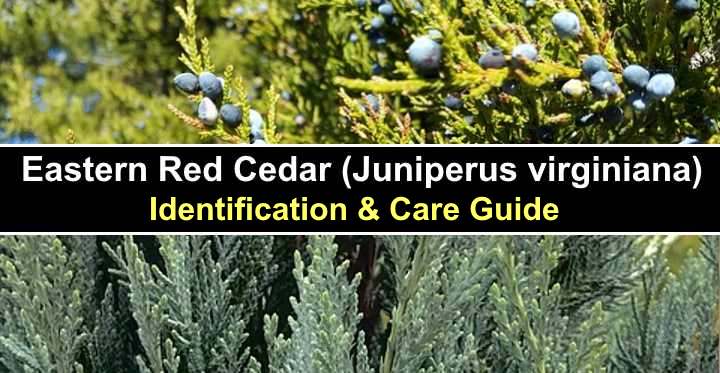
The eastern red cedar is an evergreen tree with scale-like leaves, small yellow flowers, and blue berry-like cones. The medium-sized coniferous tree is common throughout North America. The red cedar is identified by its reddish-brown bark, blueish-green leaves that turn bronze in winter, and columnar or pyramidal shape. Apart from being a tall specimen tree, easter red cedars are popular as evergreen hedge plants due to their dense foliage.
This article is a guide to identifying the eastern red cedar. Descriptions and pictures of the conifer’s leaves, flowers, fruit, and bark will help to recognize this splendid tree in the landscape.
Facts About Eastern Red Cedar (Juniperus virginiana)

Eastern red cedar (Juniperus virginiana) is not a true cedar but a type of juniper tree
The eastern red cedar (Juniperus virginiana) is a mid-sized conifer in the genus Juniperus and the family Cupressaceae. Also known as the red cedar, eastern redcedar, or Virginian juniper, the coniferous tree is not classified as a species of true cedar—genus Cedrus and family Pinaceae.
The eastern red cedar is recognizable in the landscape due to its columnar or pyramidal shape. The slow-growing tree keeps a pyramidal form in most conditions and stays as a relatively small shrub-like evergreen tree. Under ideal growing conditions, the tree matures between 16 and 66 ft. (5 – 20 m) tall.
The native range of the eastern red cedar in North America is from South Dakota in the Midwest to the east coast. In addition, the hardy evergreen conifers thrive in cold areas of USDA zone 2 in the north to zone 9 in northern Florida and the eastern part of Texas.
The eastern red cedar has the title of “most widespread native coniferous tree in the eastern United States.” Classed as a “pioneer tree,” the easy-to-grow evergreen thrives in most soil conditions, and it easily spreads in open landscapes. However, in some areas, the red cedar is considered an invasive tree.
Due to its hardiness, the eastern red cedar has many uses in the garden landscape. Its columnar growth and pointed silhouette make it an attractive specimen tree, looking like an exclamation point. Additionally, the conifer tree grows as a formal hedge. It is also a popular evergreen species to use as a Christmas tree.
Eastern Red Cedar Tree Leaves

Eastern red cedar tree leaves
Leaves on the eastern red cedar tree are identified as soft, scale-like blueish-green or dark green sprays, growing tightly together on the stems. The compact leaves grow on characteristic four-sided or square branchlets.
Immature red cedars are identified by their sharp leaves, which are needle-like in their shape and are thin and prickly.
In the landscape, the leaves of an eastern red cedar form dark green, dense foliage. Compared to other coniferous trees, the red cedar leaves keep their green color through most of the winter. Sometimes, the needle leaves turn a copper-brown color in winter.
Eastern Red Cedar Bark

Eastern red cedar bark of a mature tree
Bark on the eastern red cedar trunk and twigs is described as distinctly thin with a gray to reddish-brown color. The red cedar has identifiable peeling bark that shreds in long thin strips. The scaly bark can appear somewhat smooth on immature red cedars, and the grayish bark exfoliates, revealing red bark.
Eastern Red Cedar Flowers
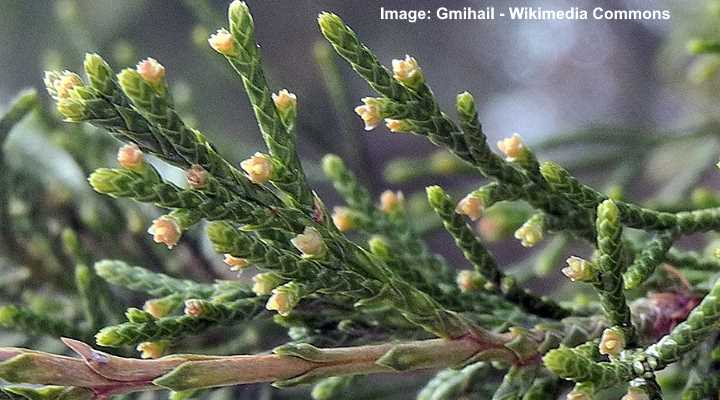
Eastern red cedar flowers are classed as strobili which are cone-like structures
Flowers on the eastern red cedar conifer are tiny golden yellow inconspicuous flowering buds. Botanically, the red cedar flowers are classed as strobili and are cone-like structures. The male red cedar flowers are oval to egg-shaped and are around 0.06” (1.5 mm) long. The greenish yellow female cedar flowers are a similar size to the male ones.
Eastern Red Cedar Fruit

Eastern red cedar fruits are also referred to as cones
Fruit from the eastern red cedar tree is small blue berry-like cones that are related to juniper berries. The small blue cedar berries have a frosted appearance and grow abundantly on the tree. The blue edible berries have a better taste than juniper berries with a sweet pine-like flavor.
Eastern Red Cedar Seed Cones

Eastern red cedar seeds
Cones on the eastern red cedar tree develop from the blue berries. The red cedar cones are irregular egg-shaped and contain one to three seeds. Eastern red cedars start producing seed-bearing cones after ten or 20 years. Typically, mature red cedars produce seed-bearing cones every two or three years.
Eastern Red Cedar Tree Growth Rate
Eastern red cedar trees have a slow to moderate growth rate. The coniferous red cedar grows around 12” to 24” (30 – 45 cm) per year and takes ten to 20 years to reach maturity at approximately 40 or 50 ft. (12 – 15 m) tall. The single-stemmed tree keeps its columnar, pyramidal appearance for most of its life.
Eastern Red Cedar Tree Identification
The eastern red cedar is identified by its dark green or bluish-green needle-like leafy sprays, abundant blue edible berries, and small rounded brown seeds. In a landscape, eastern red cedars have a recognizable pyramidal crown, and trees typically mature at around 50 ft. (15 m) tall.
Eastern Red Cedar Varieties
Several varieties of eastern red cedars are ideal for planting in a front or backyard. Red cedar cultivars grow in most soil types and are extremely cold-hardy. Dwarf, compact varieties are suitable for growing as foundation plantings, evergreen hedges, privacy screens, ground cover, or specimen trees.
Here are a few red cedar varieties:
Globe Eastern Red cedar (Juniperus virginiana ‘Globosa’) — The Globosa red juniper is a compact, rounded evergreen shrub with sprays of green scale-like needles. Growing 5 to 10 ft. (1.5 – 3 m) tall, the Globosa red cedar is ideal for planting as a hedge, foundation planting, evergreen border, or privacy screen.
Silver Eastern Red Cedar (Juniperus virginiana ‘Glauca’) — The ‘Glauca’ red cedar cultivar is a tall, skinny evergreen tree with a narrow columnar shape. This robust cultivar tolerates drought, heat, and freezing conditions. Plant the silver eastern red cedar as a tall, narrow accent specimen tree.
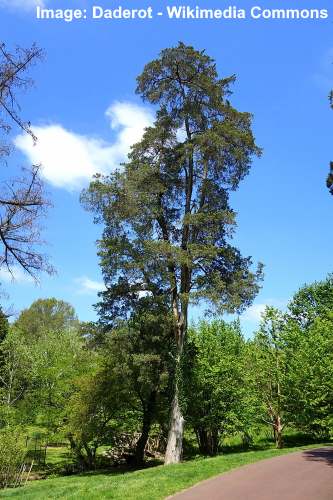
Silver Eastern Red Cedar (Juniperus virginiana ‘Glauca’)
Grey Owl Juniper (Juniperus virginiana ‘Grey Owl’) — The Grey Owl red cedar is a low-growing coniferous shrub with silvery-green scaly needles. The wide, spreading shrub grows 3 ft. (1 m) tall and up to 6 ft. (1.8 m) wide. Plant the Grey Owl junipers as ground cover for full sun, border plant, or accent plant in a small garden.
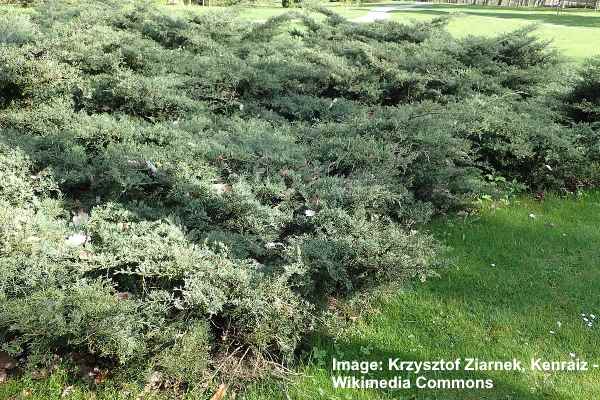
Grey Owl Juniper (Juniperus virginiana ‘Grey Owl’)
Silver Spreader Juniper (Juniperus virginiana ‘Silver Spreader’) — The Silver Spreader juniper shrub is an ideal evergreen plant for small spaces or containers. The silvery-gray soft, scaly needles form dense foliage. The Silver Spreader is perfect for ground cover, a low-growing hedge, or an evergreen plant for a winter garden growing 2 to 3 ft. (0.6 – 1 m) tall and up to 6 ft. (1.8 m) wide.
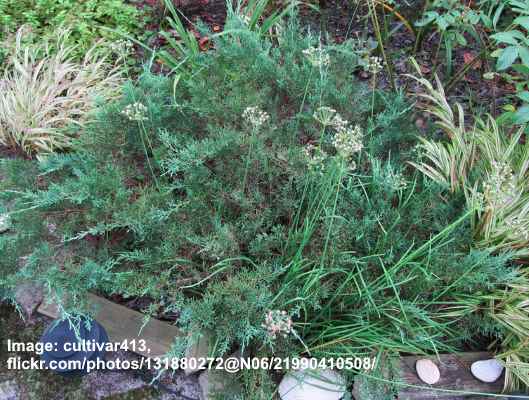
Silver Spreader Juniper (Juniperus virginiana ‘Silver Spreader’)
Eastern Red Cedar Hedge
The eastern red cedar is an ideal shrub for growing as a dense evergreen hedgerow. The tree’s columnar growth, hardiness, and compact foliage mean it will act as a perfect windbreak, privacy screen, living wall, or hedge. In addition, the shrub-like conifers thrive in all soil types—acidic and alkaline—and withstand the harshest of weather conditions.
Eastern Red Cedar Landscape Use
The eastern red cedar is a long-lived evergreen plant with aromatic foliage and berries that provide year-long visual interest. Because red cedars thrive in almost all conditions and tolerate pollution, there are plenty of options for use in your garden landscape.
For example, tall narrow cultivars are ideal as an accent or specimen plant. Some of the dwarf red cedar varieties make for excellent container plants to place on a patio, container garden, deck, or beside an entranceway. Additionally, the blue aromatic red cedar berries attract birds and other animals.
How to Plant Eastern Red Cedar Tree
Plant an eastern red cedar by choosing a sunny spot in your garden with well-draining soil. Then dig a hole three to four times larger than the container but at the same depth. Next, carefully place the root ball in the hole, making sure it grows at the same height.
After transferring the tree from the container to the ground, backfill the hole, using a shovel to firmly back the soil tight. After planting the eastern red cedar, spread a 3” to 4” (7.5 – 10 cm) layer of pine bark mulch over the root area. Remember to leave a gap of a few inches from the stem. Lastly, thoroughly water the newly planted juniper tree.
Plant the eastern cedar between 5 and 7 feet (1.5 – 2.1 m) apart to ensure adequate air circulation. Plant the cedars 2 to 3 feet (0.6 – 1 m) apart if you want to grow a red cedar hedge. This will allow the branches to grow together, forming a tightly-packed hedgerow that will protect you from wind, intruders, and prying eyes.
Top tip when planting Juniperus virginiana: The best time to plant an eastern red cedar is in the fall to allow the roots system to develop.
Where to Plant Eastern Red Cedar
Grow an eastern red cedar in full sun or partial shade in well-drained, moist soil. Ideally, the juniper tree requires between two and six or more hours of sunlight daily. Therefore, it is vital to ensure that the red cedar doesn’t grow in full shade; otherwise, its growth will be limited.
Eastern red cedars are not fussy about the soil type. The hardy, robust conifers thrive in acidic or alkaline soil but perform best in fertile soil. Even if your garden soil is rocky or sandy, you will find that the eastern red cedar thrives on minimal care and attention.
There are, however, two vital requirements when growing an eastern red cedar in your yard. First, they don’t tolerate soggy soil. So, always ensure that the growing location is well-draining. Second, ensure the tree gets at least two hours of sunshine a day.
Another consideration when growing an eastern red cedar is its susceptibility to a rust fungus called Gymnosporangium juniperi – virginianae. This cedar-apple foliage disease can affect a red cedar’s leaves and cause horns to appear. It is also destructive to apple, pear, and quince trees. Therefore, you shouldn’t plant eastern red cedars within 500 ft. (150 m) of pome fruit trees.

Rust fungus disease on eastern red cedar
Eastern Red Cedar Tree Care Guide
Let’s look at how to care for an eastern red cedar growing in your garden.
How to Water Eastern Red Cedar
Once established in the landscape, an eastern red cedar has minimal watering requirements. You can water the conifer deeply once a week during scorching weather to keep the ground moist. However, in most cases, you don’t need to provide additional water. From late fall to early spring, you don’t need to water the tree at all.
Eastern red cedars are relatively tolerant of drought. So, they can last for an extended period without any water.
With newly-planted eastern red cedars, it is vital to water the plant weekly during the first year. This helps a robust root system to develop.
When growing an eastern red cedar shrub in a container, only water the soil when the top 2” (5 cm) is dry. Then pour enough water until it drains from the pot’s drainage holes. This way, you keep the soil around the root area moist without being soggy.
Eastern Red Cedar Fertilization
Being an easy-care landscaping conifer, the eastern red cedar has minimal fertilization requirements. If you decide to apply fertilizer, choose a suitable tree fertilizer to boost woody growth rather than foliage growth. However, adding a layer of compost or pine bark mulch in the spring is usually enough to provide the juniper with enough nutrients.
Eastern Red Cedar Propagation
The easiest propagation method for eastern red cedars is by taking hardwood cuttings in late fall or winter. Cut a 3” to 6” (7.5 – 15 cm) length of branch at a 45° angle. The cutting should be flexible and have light brown bark. Remove foliage from the lower part.
To plant your cutting, place the red cedar branch directly in a soilless potting mixture. Press the soil around the red cedar cutting and seal the pot in a plastic bag. Place the container in a bright, warm room but away from direct sunlight. Keep the soil moist.
It takes around four weeks to root a red cedar cutting.
The best time to plant a rooted cutting is when it’s been growing in the container for at least three months. So, it’s best to keep the conifer growing in the pot until late fall when you can plant it in your garden.
How to Prune Eastern Red Cedar
Eastern red cedars have an attractive conical shape that requires little pruning. You only need to prune the conifer after the first year to remove some of the lower limbs. This allows access to the trunk and base of the tree. However, if you are growing an eastern red cedar hedge, trimming the foliage can help keep its shape.
Pests Affecting Eastern Red Cedar Trees
Eastern red cedars are not susceptible to many garden pests. Some pests that can cause some damage are bagworms, juniper webworms, aphids, and juniper scale insects. However, pest infestations rarely cause severe damage to the conifer.
Bagworm caterpillars are often an issue if you have eastern red cedars. The brown caterpillars create silky protective nests and only come out to feed on foliage. The best way to get rid of bagworms from a juniper tree is to remove them by hand. Unfortunately, webworms are tricky to spot and remove.
Scale insects are challenging to spot because they look like bumpy growths on the tree. However, you can dab them with rubbing alcohol to kill the sap sucking insects on contact if you notice scale.
It is easy to remove aphids by taking the hose to the tree and blasting the pesky bugs with a sharp shot of water.
Eastern Red Cedar Plant Diseases
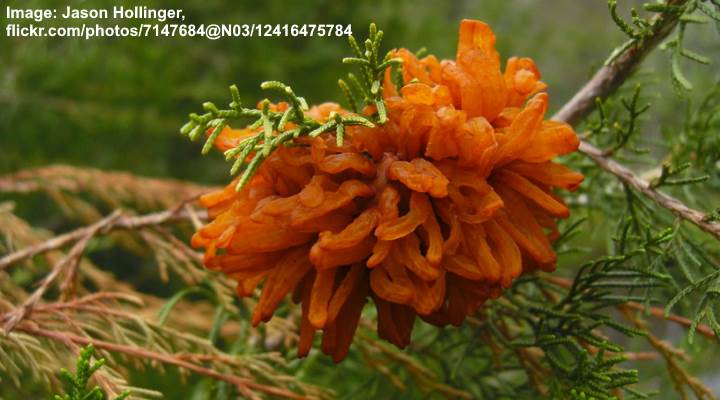
A close up picture of a cedar-apple rust disease
The most common disease to affect eastern red cedars is cedar-apple rust. This disease causes jelly-like horns to grow on twigs and branches. You are most likely to see the condition appear in spring after warm, rainy weather. Therefore, the best way to deal with cedar-apple rust is to remove the affected branches in spring.
You may see the twigs develop brown tips if the twig blight affects the red cedar conifer. Again, removing the affected branches is the best way to improve your tree’s health.
Root rot is another issue when growing an eastern red cedar tree. The best way to avoid diseased roots from affecting a juniper tree’s growth is to avoid overwatering it. Established red cedars are incredibly tolerant of drought and can grow for extended periods without additional watering.
Related articles:
